| Listing 1 - 10 of 22 | << page >> |
Sort by
|
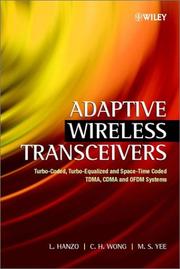
ISBN: 0470846895 9780470846896 9780470847763 047084776X 1280555564 9786610555567 Year: 2002 Publisher: New York (N.Y.): Wiley,
Abstract | Keywords | Export | Availability | Bookmark
 Loading...
Loading...Choose an application
- Reference Manager
- EndNote
- RefWorks (Direct export to RefWorks)
Adaptive Wireless Transceivers provides the reader with a broad overview of near-instantaneously adaptive transceivers in the context of TDMA, CDMA and OFDM systems. The adaptive transceivers examined employ powerful turbo codecs, turbo equalisers and space-time codecs, equipping the reader with a future-proof technological road map. It demonstrates that adaptive transceivers are capable of mitigating the channel quality fluctuations of the wireless channel as a lower-complexity alternative to space-time coding. By contrast, if the higher complexity of multiple transmitters and multiple receiver-assisted systems is deemed acceptable, the advantages of adaptability erode. . Provides an in-depth introduction to channel equalisers and Kalman filtering and discusses the associated complexity versus performance trade-offs . Introduces wideband near-instantaneously adaptive transceivers and studies their performance both with and without turbo channel coding . Describes how to optimise adaptive modulation mode switching and highlights a range of practical considerations . Introduces neural network based channel equalisers and discusses Radial Basis Function (RBF) assisted equalisers embedded into adaptive modems supported by turbo channel coding and turbo channel equalisation . Employs the above adaptive principles also in the context of CDMA and OFDM transceivers and discusses the pros and cons of space-time coding versus adaptive modulationResearchers, advanced students and practising development engineers working in wireless communications will all find this valuable text an informative read.
Radio --- Modulation (Electronics) --- Wireless communication systems --- Adaptive filters --- Adaptive antennas --- Transmitter-receivers --- Wireless communication systems. --- Adaptive filters. --- Adaptive antennas. --- Transmitter-receivers. --- Radio - Transmitter-receivers
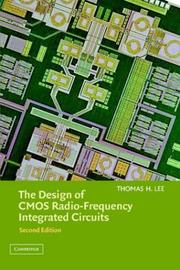
ISBN: 0521835399 9780521835398 Year: 2004 Publisher: Cambridge: Cambridge university press,
Abstract | Keywords | Export | Availability | Bookmark
 Loading...
Loading...Choose an application
- Reference Manager
- EndNote
- RefWorks (Direct export to RefWorks)
This expanded and thoroughly revised edition of Thomas H. Lee's acclaimed guide to the design of gigahertz RF integrated circuits features a completely new chapter on the principles of wireless systems. The chapters on low-noise amplifiers, oscillators and phase noise have been significantly expanded as well. The chapter on architectures now contains several examples of complete chip designs that bring together all the various theoretical and practical elements involved in producing a prototype chip. First Edition Hb (1998): 0-521-63061-4 First Edition Pb (1998); 0-521-63922-0
Metal oxide semiconductors, Complementary --- Radio frequency integrated circuits --- Radio --- Design and construction --- Transmitter-receivers --- 621.3'7 --- Electrical engineering--?'7 --- Design and construction. --- Transmitter-receivers. --- 621.3'7 Electrical engineering--?'7 --- Radio transceivers --- Radio transmitter-receivers --- Transceivers --- RFICs (Integrated circuits) --- Integrated circuits --- Radio circuits --- Metal oxide semiconductors, Complementary - Design and construction --- Radio frequency integrated circuits - Design and construction --- Radio - Transmitter-receivers --- CMOS --- 621.382
Book
ISBN: 012378641X 0123786401 9780123786418 Year: 2014 Publisher: Oxfordshire, England ; Waltham, Massachusetts : Academic Press,
Abstract | Keywords | Export | Availability | Bookmark
 Loading...
Loading...Choose an application
- Reference Manager
- EndNote
- RefWorks (Direct export to RefWorks)
Wireless Receiver Architectures and Design presents the various designs and architectures of wireless receivers in the context of modern multi-mode and multi-standard devices. This one-stop reference and guide to designing low-cost low-power multi-mode, multi-standard receivers treats analog and digital signal processing simultaneously, with equal detail given to the chosen architecture and modulating waveform. It provides a complete understanding of the receiver's analog front end and the digital backend, and how each affects the other. The book explains the design process in great
Radio --- Wireless communication systems --- Electrical & Computer Engineering --- Engineering & Applied Sciences --- Electrical Engineering --- Transmitter-receivers --- Transmitter-receivers. --- Industrial applications. --- Communication systems, Wireless --- Wireless data communication systems --- Wireless information networks --- Wireless telecommunication systems --- Telecommunication systems --- Radio transceivers --- Radio transmitter-receivers --- Transceivers
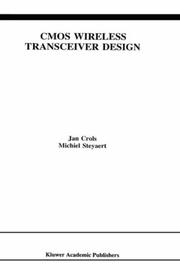
ISBN: 0792399609 1441951830 1475747845 9780792399605 Year: 1997 Volume: SECS 411 Publisher: Boston: Kluwer,
Abstract | Keywords | Export | Availability | Bookmark
 Loading...
Loading...Choose an application
- Reference Manager
- EndNote
- RefWorks (Direct export to RefWorks)
The world of wireless communications is changing very rapidly since a few years. The introduction of digital data communication in combination with digital signal process ing has created the foundation for the development of many new wireless applications. High-quality digital wireless networks for voice communication with global and local coverage, like the GSM and DECT system, are only faint and early examples of the wide variety of wireless applications that will become available in the remainder of this decade. The new evolutions in wireless communications set new requirements for the trans ceivers (transmitter-receivers). Higher operating frequencies, a lower power consump tion and a very high degree of integration, are new specifications which ask for design approaches quite different from the classical RF design techniques. The integrata bility and power consumption reduction of the digital part will further improve with the continued downscaling of technologies. This is however completely different for the analog transceiver front-end, the part which performs the interfacing between the antenna and the digital signal processing. The analog front-end's integratability and power consumption are closely related to the physical limitations of the transceiver topology and not so much to the scaling of the used technology. Chapter 2 gives a detailed study of the level of integration in current transceiver realization and analyzes their limitations. In chapter 3 of this book the complex signal technique for the analysis and synthesis of multi-path receiver and transmitter topologies is introduced.
Complementaire MOS transistoren --- Complementary metal oxide semiconductors --- MOS Transistoren [Complementaire ] --- Metal oxide semiconductors [Complementary ] --- Semiconductors [Complementary metal oxide ] --- Transistors MOS complémentaires --- Radio --- Metal oxide semiconductors, Complementary --- Signal processing --- Transmitter-receivers --- Design and construction --- Digital techniques --- Radio--Transmitter-receivers --- Electrical engineering. --- Computer-aided engineering. --- Electrical Engineering. --- Computer-Aided Engineering (CAD, CAE) and Design. --- CAE --- Engineering --- Electric engineering --- Data processing --- Radio - Transmitter-receivers - Design and construction --- Signal processing - Digital techniques
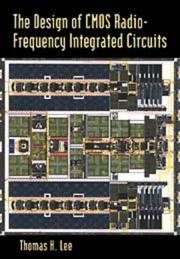
ISBN: 0521630614 0521639220 9780521639224 9780521630610 Year: 1998 Publisher: Cambridge : Cambridge university press,
Abstract | Keywords | Export | Availability | Bookmark
 Loading...
Loading...Choose an application
- Reference Manager
- EndNote
- RefWorks (Direct export to RefWorks)
Metal oxide semiconductors, Complementary --- Integrated circuits --- Radio --- MOS complémentaires --- Circuits intégrés --- Design and construction. --- Transmitter-receivers. --- Conception et construction --- Emetteurs-récepteurs --- Radio frequency integrated circuits --- Design and construction --- Transmitter-receivers --- 621.3'7 --- #KVIV:BB --- Electrical engineering--?'7 --- 621.3'7 Electrical engineering--?'7 --- Radio transceivers --- Radio transmitter-receivers --- Transceivers --- RFICs (Integrated circuits) --- Radio circuits --- Metal oxide semiconductors, Complementary - Design and construction --- Radio frequency integrated circuits - Design and construction --- Radio - Transmitter-receivers
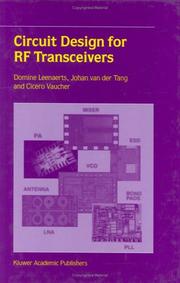
ISBN: 9780792375517 0792375513 9780306479786 0306479788 Year: 2001 Publisher: Boston: Kluwer,
Abstract | Keywords | Export | Availability | Bookmark
 Loading...
Loading...Choose an application
- Reference Manager
- EndNote
- RefWorks (Direct export to RefWorks)
Circuit Design for RF Transceivers covers key building blocks which are needed to make an integrated transceiver for wireless and cellular applications, that is low-noise amplifiers, mixers, voltage controlled oscillators, RF power amplifiers and phase-locked loop systems. Starting from detailed RF concepts and specifications, the authors discuss the circuits in detail and provide solutions to many design problems. The circuits are implemented in a wide range of modern technology processes. Production requirements are taken into account, and measurement results are presented and discussed. Several of the presented circuits are used in IC products. The text also includes several RF technologies (for example double-poly, Silicon-on-Anything, SiGe-bipolar, RF-CMOS, etc.) and microwave design techniques, such as transmission line concepts. In addition, the problem of connecting the RF signals on-chip to the PCB and to the antenna will be discussed, including the influence of the package, ESD and bond pads. The contents of Circuit Design for RF Transceivers 2nd edition are based on research activities carried out at Philips Research. Many internal and external publications contributed to make the presented material state-of-the-art. The book is written for people who have a basic knowledge of analogue IC design. The second edition of this successful 2001 RF Circuit Design book has been updated, latest technology reviews have been added as well as several actual case studies. Due to the authors being active in industry as well as academia, this should prove to be an essential guide on RF Transceiver Design for students and engineers.
Radio circuits --- Radio --- Circuits radio --- Design and construction. --- Transmitter-receivers --- Conception et construction --- Emetteurs-récepteurs --- Design and construction --- Computer engineering. --- Engineering. --- Radio - Transmitter-receivers - Design and constru. --- Systems engineering. --- Electrical & Computer Engineering --- Engineering & Applied Sciences --- Electrical Engineering --- Electrical engineering. --- Electronic circuits. --- Circuits and Systems. --- Electrical Engineering. --- Electric engineering --- Engineering --- Electron-tube circuits --- Electric circuits --- Electron tubes --- Electronics --- Telephone, Wireless --- Wireless (Radio) --- Wireless telephone (Early radio) --- Communication and traffic --- Telecommunication --- Telegraph, Wireless --- Radio circuits - Design and construction --- Radio - Transmitter-receivers - Design and construction
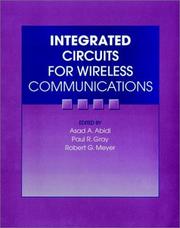
ISBN: 0780334590 9780780334595 Year: 1998 Publisher: New York : [Piscataqay, New Jersey] : IEEE Press, IEEE Xplore,
Abstract | Keywords | Export | Availability | Bookmark
 Loading...
Loading...Choose an application
- Reference Manager
- EndNote
- RefWorks (Direct export to RefWorks)
"High-frequency integrated circuit design is a booming area of growth that is driven not only by the expanding capabilities of underlying circuit technologies like CMOS, but also by the dramatic increase in wireless communications products that depend on them. INTEGRATED CIRCUITS FOR WIRELESS COMMUNICATIONS includes seminal and classic papers in the field and is the first all-in-one resource to address this increasingly important topic.Internationally known and highly regarded in the field, editors Asad Abidi, Paul Gray, and Robert Meyer have meticulously compiled more than 100 papers and articles covering the very latest high-level integrated circuits techniques and solutions in use today. INTEGRATED CIRCUITS FOR WIRELESS COMMUNICATIONS is devised expressly to provide IC design engineers, system architects, and integrators with a practical understanding of subjects ranging from architecture choices for integrated transceivers to actual circuit designs in all viable IC technologies such as bipolar, CMOS, and GaAs. The papers selected represent a breadth of coverage and level of expertise that is unmatched in the field." Sponsored by: IEEE Solid-State Circuits Council/Society.
Integrated circuits --- Wireless communication systems --- Radio --- Equipment and supplies --- Transmitter-receivers --- Integrated circuits. --- -Wireless communication systems --- -Communication systems, Wireless --- Wireless data communication systems --- Wireless information networks --- Wireless telecommunication systems --- Telecommunication systems --- Telephone, Wireless --- Wireless (Radio) --- Wireless telephone (Early radio) --- Communication and traffic --- Telecommunication --- Telegraph, Wireless --- Chips (Electronics) --- Circuits, Integrated --- Computer chips --- Microchips --- Electronic circuits --- Microelectronics --- -Transmitter-receivers --- Electrical & Computer Engineering --- Engineering & Applied Sciences --- Electrical Engineering --- Equipment and supplies. --- Transmitter-receivers. --- Radio transceivers --- Radio transmitter-receivers --- Transceivers --- Wireless communication systems - Equipment and supplies --- Radio - Transmitter-receivers
Book
ISBN: 3319033670 3319000977 3319000985 Year: 2013 Publisher: New York : Springer,
Abstract | Keywords | Export | Availability | Bookmark
 Loading...
Loading...Choose an application
- Reference Manager
- EndNote
- RefWorks (Direct export to RefWorks)
This book describes the design of ultra low power transceivers for body area networks. Since these applications have very limited energy resources, typically powered only by tiny batteries or through energy harvesting techniques, this book describes an architecture for a Bluetooth low energy transceiver to overcome these limitations. Coverage includes not only the main concepts for achieving low power consumption, but also the details of the circuit design and its implementation in a standard CMOS technology. · Guides readers through the design of ultra low power transceivers for body area networks, from architecture to circuit-level implementation; · Describes 4 key strategies for ultra-low power transceiver design and specific, innovative techniques for circuit-level design; · Enables readers to design transceivers for body area networks that are 27% more energy efficient than those currently available; · Includes a review of the state-of-the-art in low-power transceivers in the GHz frequency range.
Assistive computer technology. --- Low voltage integrated circuits. --- Radio -- Transmitter-receivers. --- Wireless communication systems in medical care. --- Electrical & Computer Engineering --- Engineering & Applied Sciences --- Electrical Engineering --- Radio --- Transmitter-receivers. --- Radio transceivers --- Radio transmitter-receivers --- Transceivers --- Transmitter-receivers --- Low power consumption chips --- Low power integrated circuits --- Reduced voltage integrated circuits --- Engineering. --- Electronic circuits. --- Electronics. --- Microelectronics. --- Circuits and Systems. --- Electronics and Microelectronics, Instrumentation. --- Electronic Circuits and Devices. --- Integrated circuits --- Low voltage systems --- Systems engineering. --- Electrical engineering --- Physical sciences --- Engineering systems --- System engineering --- Engineering --- Industrial engineering --- System analysis --- Design and construction --- Microminiature electronic equipment --- Microminiaturization (Electronics) --- Electronics --- Microtechnology --- Semiconductors --- Miniature electronic equipment --- Electron-tube circuits --- Electric circuits --- Electron tubes
Book
ISBN: 1608075044 9781608075041 9781608075034 1608075036 Year: 2013 Publisher: Norwood, Massachusetts : [Piscataqay, New Jersey] : Artech House, IEEE Xplore,
Abstract | Keywords | Export | Availability | Bookmark
 Loading...
Loading...Choose an application
- Reference Manager
- EndNote
- RefWorks (Direct export to RefWorks)
Written by the developers of the new 21st century HF (high frequency) radio technology, this groundbreaking resource presents the powerful new capabilities and technical details of 3G and WBHF (wideband high frequency) waveforms to help you understand and use the ionospheric channel for video and high-speed data transmission.Featuring more than 150 illustrations, this practical book enables you to utilize this technology to communicate voice and data over the horizon without needing anyone else's infrastructure, send video beyond line of sight from moving platforms, and communicate over long r
Radio --- Radio frequency identification systems. --- Ultra-wideband devices. --- Telephone, Wireless --- Wireless (Radio) --- Wireless telephone (Early radio) --- Communication and traffic --- Telecommunication --- Telegraph, Wireless --- Radio transceivers --- Radio transmitter-receivers --- Transceivers --- Transmitter-receivers --- Ultra-broadband devices --- Ultrawideband devices --- Electromagnetic devices --- Identification systems, Radio frequency --- RF/ID systems --- RFID systems --- Identification --- Radio telemetry --- Near-field communication --- Transmitter-receivers. --- Receivers and reception --- Design and construction. --- Equipment and supplies
Book
ISBN: 128337160X 9786613371607 0470634448 0470634456 9780470634455 9780470277119 0470277114 9781283371605 9780470634448 Year: 2011 Publisher: New York : Wiley,
Abstract | Keywords | Export | Availability | Bookmark
 Loading...
Loading...Choose an application
- Reference Manager
- EndNote
- RefWorks (Direct export to RefWorks)
State-of-the-art and beyond technologies to be used in future multi-mode wireless communication systemsCurrent and future mobile terminals become increasingly complex because they have to deal with a variety of frequency bands and communication standards. Achieving multiband/multimode functionality (3G and beyond) is especially challenging for the RF-transceiver section.This volume presents cutting-edge physical layer technologies for multi-mode wireless RF transceivers, specifically RF, analog, and mixed-signal and digital circuits and architectures. Providing the most comprehensive treatment of this topic available, it features original contributions from distinguished researchers and professionals from both academia and industry, who anticipate the major trends and needs of future wireless system developments.Divided into four sections, Multi-Mode/Multi-Band RF Transceivers for Wireless Communications covers:. Transceiver concepts and design: software-defined radio front-ends/transceivers, adaptive multi-mode RF front-end circuits, delay alignment between amplitude and phase paths in a digital polar transmitter, and front-end RF passive integration, as well as versatile data converters. Receiver design: OFDM transform-domain receivers for multi-standards, discrete-time processing of RF signals, oversampled ADC using VCO-based quantizers, RF receiver front-ends for mobile terminals, and digitally enhanced alternate path linearization of RF receivers. Transmitter techniques: Linearity and efficiency strategies, CMOS RF power amplifiers for mobiles, and digitally assisted RF architectures. Digital Signal Processing for RF transceivers: RF impairment compensation for future radio systems, techniques for the analysis of digital bang-bang PLLs, and low-power spectrum processors for cognitive radiosThe remarkable insight into the essential transceiver building blocks to be used in future multi-mode wireless communication systems makes this an invaluable resource for engineers and researchers from academia and industry working on circuits and architectures of wireless transceivers, as well as for RF design engineers in semiconductor companies and graduate students taking advanced courses on wireless communication circuits.
Radio --- Wireless communication systems --- Cell phones --- Wireless LANs --- Transmitter-receivers. --- Equipment and supplies --- Design and construction. --- Cell telephones --- Cellphones --- Cellular phones --- Cellular radio --- Cellular telephones --- Mobile phones --- Mobiles (Telephones) --- Phones, Cell --- Telephones, Cell --- Wireless phones --- Telephone --- Radio transceivers --- Radio transmitter-receivers --- Transceivers --- Transmitter-receivers --- Equipment and supplies&delete& --- Design and construction --- Wi-Fi LANs --- WiFi LANs --- Wireless local area networks --- WLANs (Wireless LANs) --- Local area networks (Computer networks) --- Communication systems, Wireless --- Wireless data communication systems --- Wireless information networks --- Wireless telecommunication systems --- Telecommunication systems
| Listing 1 - 10 of 22 | << page >> |
Sort by
|

 Search
Search Feedback
Feedback About UniCat
About UniCat  Help
Help News
News